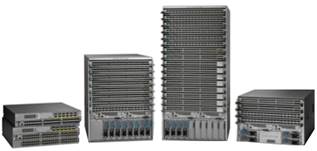Designed to meet both current and emerging needs for multiple stages of network transformation, the Cisco Nexus 9000 product family includes both modular (Nexus 9500 switches) and fixed-port switches (Nexus 9300 switches).
By providing two modes of operation, the Cisco Nexus 9000 Series Switches are the next generation of data center switching infrastructure. The Nexus 9000 can be used in NXOS mode for traditional 3-tier architectures, Spine-Leaf (CLOS) architectures, or Generation 1 SDN solutions such as OpenFlow. In ACI mode the Nexus 9000 offers the industry’s leading architecture for the next generation of data center networking. ACI provides advanced capabilities and an operational model focused on the application to drive business forward.
• Cisco NX-OS mode for traditional architectures and consistency across the Cisco Nexus portfolio
• ACI mode to take full advantage of the policy-driven services and infrastructure automation features of ACI
More Details of Cisco NX-OS Mode and ACI Mode
Cisco NX-OS Mode
The Cisco NX-OS mode of the Cisco Nexus 9000 Series provides important customer benefits, referred to as the Five 5 P’s:
● Price: Industry-leading price per port for 10- and 40-Gbps density systems
● Performance: Industry-leading performance with full line-rate nonblocking 40-Gbps performance
● Port density: Leading port density, with 288 ports of 40-Gbps connectivity per 8-slot chassis
● Programmability: Leading suite of programmability features to enable emerging networking models, including first-generation SDN, automation, and development and operations (DevOps) solutions
● Power: The most efficient chassis in its class, consuming up to 15 percent less power per port than competing solutions
In addition to these benefits, the Cisco Nexus 9000 Series in Cisco NX-OS mode offers these major advantages:
● Best platform for migration from 1 Gbps to 10 Gbps
● Best platform for migration from 10 Gbps to 40 Gbps
● Optimal platform for replacement of traditional Cisco Catalyst 6000 Series Switches in the data center with a solution with a smaller footprint, lower power draw, and 10- and 40-Gbps ports all with equal copper port density
● Designed from the foundation to enable and accelerate Cisco ACI
The portfolio consists of a broad set of hardware components, with more scheduled for release this year. The current offerings are:
● Modular chassis options
– Cisco Nexus 9504 Switch
– 4 payload slots
– Up to 576 full line-rate 1- and 10-Gbps ports
– Up to 144 full line-rate 40-Gbps ports
– Cisco Nexus 9508 Switch
– 8 payload slots
– Up to 1152 full line-rate 1- and 10-Gbps ports
– Up to 288 full line-rate 40-Gbps ports
– Cisco Nexus 9516 Switch
– 16 payload slots
– Up to 2304 full line-rate 1- and 10-Gbps ports
– Up to 576 full line-rate 40-Gbps ports
● Fixed-switch options
– Cisco Nexus 9396PX Switch
– 48 ports of 1- and 10-Gbps fiber Enhanced Small Form-Factor Pluggable (SFP+)
– 12 ports of 40-Gbps fiber Quad SFP (QSFP)
– Cisco Nexus 9396TX Switch
– 48 ports of 1- and 10-Gbps fiber SFP+
– 12 ports of 40-Gbps fiber QSFP
– Cisco Nexus 93128TX Switch
– 96 ports of 1- and 10-Gbps copper RJ-45
– 8 ports of 40-Gbps fiber QSFP
All these benefits are enhanced by Cisco’s innovative 40-Gbps bidirectional (BiDi) optics. These standards-based QSFP optics provide 40-Gbps speeds on existing 10-Gbps infrastructure at approximately the same cost as current 10-Gbps optics. These optics are an exclusive Cisco option to help increase adoption of 40-Gbps solutions.
Cisco ACI Mode
Cisco ACI mode enables the next generation of SDN. Rather than focusing solely on technical problems, accelerating deployment of today’s networks, with their complexity, Cisco ACI also focuses on the business problem of how to rapidly deploying applications to meet changing demands. Cisco ACI mode provides a balanced approach of hardware and software acceleration for network infrastructure, including Layer 4 through 7 services, through the language of applications. The baseline capabilities of automation, programmability, and centralized provisioning that are the focus of first-generation SDN solutions are built into Cisco ACI at the foundation. Cisco ACI then enhances these capabilities by allowing the network to be automated and programmed based on business-level application requirements.
Cisco ACI Mode
The benefits of Cisco ACI include:
● Accelerated, cohesive deployment of applications across network and Layer 4 through 7 infrastructure
● Application-level visibility and management
● Open ecosystem designed to work with any upper-level management or orchestration system and build a community of developers to expand the benefits
● Advanced telemetry for visibility into network health and simplified day-two operations
● Integration and automation of Cisco and third-party Layer 4 through 7 virtual and physical service devices
To enable Cisco ACI mode, the Cisco Nexus 9000 Series hardware portfolio is coupled with the Cisco Application Policy Infrastructure Controller (APIC) and new operating system software for the switching platform. In addition, a broad ecosystem of third-party integration includes:
● Virtual or physical Layer 4 through 7 services
● Management systems
● Orchestration systems
● Monitoring systems
With Cisco ACI mode, customers can deploy the network based on application requirements, removing the need to accommodate the complexity of current network constraints. It provides this feature while also helping ensure security and performance and maintaining complete visibility into application health on both virtual and physical resources.
The Cisco Nexus 9000 Series Switches are the next generation of data center switching infrastructure. In Cisco NX-OS Software mode, the Cisco Nexus 9000 Series addresses the new challenges of current infrastructure designs, while building on first-generation software-defined networking (SDN) solutions and providing a path to Cisco Application Centric Infrastructure (ACI). In Cisco ACI mode, the Cisco Nexus 9000 Series provides the industry’s most advanced answer to SDN with a powerful combination of hardware and software custom developed to provide a more robust and comprehensive solution than anything else available on the market.
More Related Cisco Nexus Switch Topics
Nexus 7000 and Catalyst 6500 Comparison Guide
Cisco Nexus 3100, Ready to Support VMware NSX?
Cisco Nexus 6000 Switches: High-Density, Compact Form Factor


